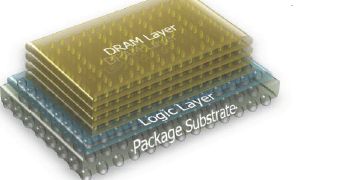Micron and Samsung Electronics just announced the formation of an open consortium for OEMs, enablers and integrators that will collaborate in developing and implementing the interface specifications for Hybrid Memory Cube (HMC).
This technology brings together DRAM memory and logic processes into just one package to offer all sort of advantages over traditional computer memory, such as increased power efficiency, bandwidth, density and scalability.
The goal of this consortium is to establish HMC as a new memory standard, and the first meetings will begin later this month with the first draft specifications expected to arrive in 2012.
Compared to traditional DRAM memory, HMC uses a three-dimensional design with a series of stacked layers linked together through a fast inter-connect.
According to the two companies, this design should deliver higher performance while requiring lower power, which makes it well suitable for a series of applications ranging from from networking and data center to consumer products such as media tablets and memory cards.
In addition, the technology also promises to deliver wider and higher-speed local data buses, advanced memory controller functions, and better DRAM control, while at the same time it also reduces the memory controller complexity and increases efficiency.
“HMC is unlike anything currently on the radar,” said Robert Feurle, Micron’s Vice President for DRAM Marketing.
“HMC brings a new level of capability to memory that provides exponential performance and efficiency gains that will redefine the future of memory.
“Guidance by the industry consortium will help drive the fastest possible adoption of the technology, resulting in what we believe will be radical improvements to computing systems,” concluded Mr. Feurle.
At the 2011 IDF conference, which took place just the last month, Intel and Micron presented a HMC platform that was validated to run at 128 FB/s, all while providing significant bandwidth, density and energy efficiency improvements, according to Micron.

 14 DAY TRIAL //
14 DAY TRIAL //